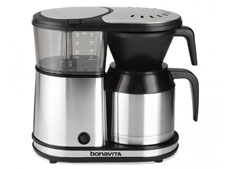It’s the time of year for saving money!
I’ve been a coffee lover for about as long as I’ve been a music lover. In fact, I got my introduction to coffee when I took a morning paper route so I could make enough money to buy my first electric guitar, and my Dad brought me a cup as I was folding papers in the garage at 4 am on the first morning of my new job. But as much as we like to think of audio as a religious experience, elevated above the other consumer products we buy, I was struck last night by how similar the two pursuits are.
 Specifically, if you don’t invest a little time to learn about them, and a little extra money to get something better than average, you are almost certainly going to have an unsatisfying experience.
Specifically, if you don’t invest a little time to learn about them, and a little extra money to get something better than average, you are almost certainly going to have an unsatisfying experience.
Most coffeemakers are roughly equivalent in quality to a typical $50 Bluetooth speaker. Most of them are cranked out to hit a certain price point. As long as they perform the basic function for which they’re intended, they’re considered “good enough.”
The main problem with mass-market coffeemakers (a designation that includes even some supposedly upscale marques such as Cuisinart) is that they don’t heat the water enough to get all the flavor out of the coffee beans. Essentially, they don’t “cook” the coffee enough. A typical mass-market coffeemaker might heat the water to about 160° or 170°F. A coffeemaker approved by the Specialty Coffee Association of America must, among other requirements, heat water to at least 92°C (197.6°F) and never exceed 96°C (204.8°F).
The difference you get with a high-temperature coffeemaker like the Bonavita model I use is, in my opinion, easily worth the much higher price of the coffeemaker relative to the mass-market models you get at Target or even Macy’s or Bed Bath & Beyond. Before I got my Bonavita, the quality of my coffee varied greatly from batch to batch, even sometimes with beans from the same bag. Often it was so bad I just threw it out. Yet I can’t remember ever brewing a bad cup of coffee with this coffeemaker in the two years I’ve had it. It even gets very drinkable pots of coffee out of some cheap Trader Joe’s beans that I’d previously considered unusable.
Last night I had almost exactly the same experience while working on a review of the new Thiel TT1 tower speaker, connected at the time to a Classé Audio CP-800 digital preamp and CA-2300 power amp. Flipping through the music stored on my music computer, I stumbled upon Neil Diamond’s Rainbow, which is an interesting album because it’s a great songwriter covering works by other great songwriters. I don’t think anyone would call Rainbow a great recording — it’s a 1973 pop album, after all — but the experience I had with it was mesmerizing. Diamond’s voice sounded remarkably natural and intimate; I got the “floating head between the speakers” effect I’ve often heard from some of the best high-end rigs. On the arrangement of Joni Mitchell’s “Chelsea Morning,” the detail and natural presentation of the acoustic guitars and congas and strings made the tune fill the room; every instrument seemed to have its own little sonic space carved out for it.
Through the same system, on the same night, I also heard Rush’s Moving Pictures, an album I have to confess I’d only previously heard on car systems, headphones or whatever stereo I had cobbled together in the early 1980s. On my favorite track, “Red Barchetta,” I noticed that in the bridge, Geddy Lee’s vocals are split among the channels and phase-shifted slightly so they float around and above the speakers rather than coming from dead-center. Somehow, they accomplished this effect without introducing significant amounts of nasty comb filtering (i.e., the boosting of certain frequencies and cutting of adjacent frequencies) that commonly occurs when there’s a relative phase shift between audio channels. To put it simply, the effect was compelling and subtle, not stupid. Yet on the mediocre systems I’ve heard this track on before, I never even noticed it.
It made me sad to realize that 99% of Rush fans may never hear this little audio mixing masterstroke. Just as perhaps 99% of the people who buy good coffee won’t ever know how good that coffee really is because their coffeemaker sucks.
It’s easy for me to get jaded sometimes because so much good audio gear comes through my home, but my experience last night reminded me that if you’re a serious music lover, you really need to get a decent stereo system in order to appreciate the craft and emotion that went into the music you’re listening to. Just as you really need to get a good coffeemaker to appreciate the incredibly satisfying flavor of fresh-roasted, fresh-ground coffee beans.





